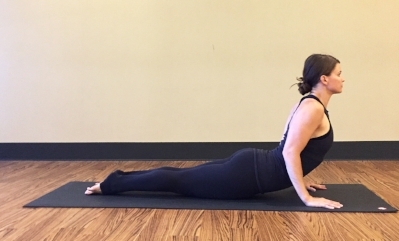Bhujangasana--Cobra Pose
The deeper I've gotten into my practice and teaching I've come to realize that yoga isn't just about range of motion and flexibility. It's also incredibly important to work low range of motion postures and emphasize strength. Although it's sometimes seen as a modification for Upward Facing Dog, Bhujangasana--Cobra Pose is a posture that stands on its own. It might seem like a fairly straightforward posture, but there's a lot of subtlety to this backbend.
Start Small
Something I appreciate about Cobra is that it's one posture with a lot of range options. Early in practice I like to throw in a very low Cobra to get the back of the body warm. No need to push too far, keep it mild. Press down through the tops of your feet, engage your legs, place a tiny bit of weight in your hands, and lift your head, neck, and shoulders. Be mindful to keep the abdominals engaged. It's easy to simply push your belly into your mat to create leverage, but in order to maintain a happy lower back pull your navel away from the floor.
Hand Placement
I believe in experimentation in a yoga practice and Cobra is no exception. Play with where you place your hands in relationship to your shoulders. With time I've settled on placing my hands fairly low, closer to the middle of my ribs. How do you know if your hands are in the "right" place? Find a place where you're able to easily draw the shoulders down toward your hips. If the hands are placed too close to the shoulders the shoulders often start rounded forward and they'll probably stay there as you progress further. Last note on the hands, use them! In order to fire more muscles on the backside get a little grippy with your hands. Without moving the hands pull back and drag your chest forward.
Take it Higher
Once you're a bit warmed, play with taking Cobra a little higher. No need to rush it, of course, but there's value in experimenting with a bigger backbend. Be mindful that your elbows stay bent. You're not transitioning into Upward Facing Dog. Firm your legs, engage your abdominals, and use your hands and arms to pull the chest forward. You'll quickly start to feel the muscles around your shoulders and spine.
Although this is one of the least satisfying postures in my body, I know it's one to keep working into my practice. The muscles that fire in Cobra are muscles that often stay dormant in a Vinyasa practice due to the emphasis on pushing over pulling. In my own practice I've noticed a lot more strength and control in Chaturanga and various arm balances and I believe it's due to working Cobra and other prone backbends with more regularity.
Give it a shot and let me know what you think!

